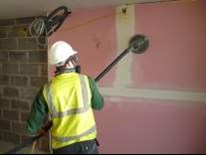Advice for employers
Employers have a legal responsibility to protect their workers against construction dust. Here are simple steps you can take to meet these responsibilities.
Assess the risks linked to the work and materials. High dust levels are caused by one or more of the following:
- Task
the more energy the work involves, the bigger the risk. High energy tools like cut-off saws, grinders and grit blasters produce a lot of dust in a very short time
- Work area
the more enclosed a space, the more the dust will build up. However, do not assume that dust levels will be low when working outside with high energy tools
- Time
the longer the work takes the more dust there will be
- Frequency
regularly doing the same work day-after-day increases the risks.
You may need to use a range of controls to manage the dust.
Eliminate / Reduce: Look at the ways to stop or reduce the amount of dust you might make before work starts. Could you can achieve the same result by:
- design changes
- using different materials

- using different tools or work methods
Control at Source: Where this cannot be done, it is important to stop dust getting into the air. Think about using:
- water suppression
- on-tool extraction
Masks
Some tasks produce so much dust that water suppression or on-tool extraction is not enough on its own. In these cases masks or other respiratory protective equipment (RPE) will also be needed. Remember; a mask is the last line of protection and should only be used once the other controls have been used.
Training
Make sure your workers are aware of the health risks associated with exposure to construction dusts and know what procedures they should be following.
Train them in use and maintenance of any new equipment. This should include how to wear face masks correctly, maintain them and keep them clean.
Other Controls
You may need to combine these controls in some situations with other measures like keeping other people away from the work, stopping any dust spreading with sheeting, rotating those doing the work or getting extra ventilation to the work area.
Have procedures to ensure that work is done in the right way. Check that the controls are effective and maintain the equipment. You may have to put a health surveillance programme in place.
How can I find out more?
Check the Resources page for more useful information.